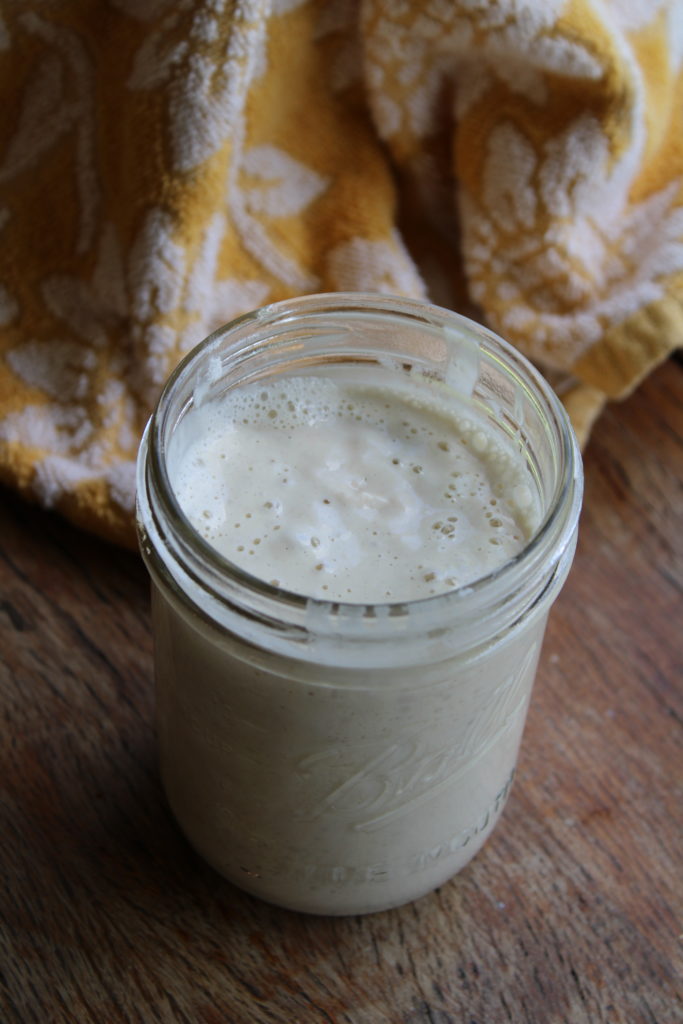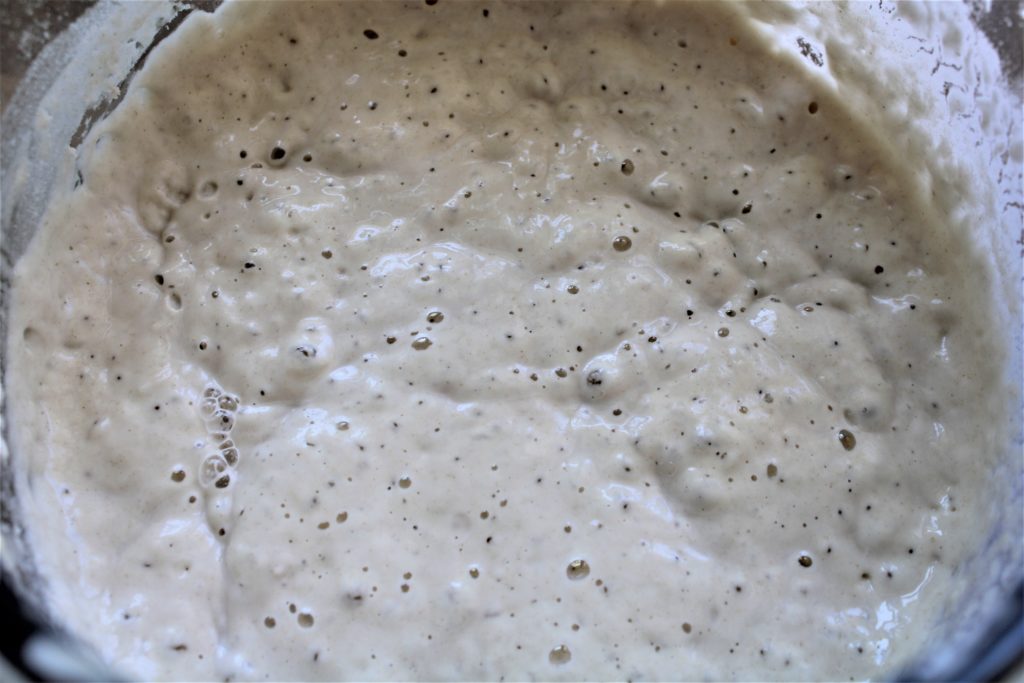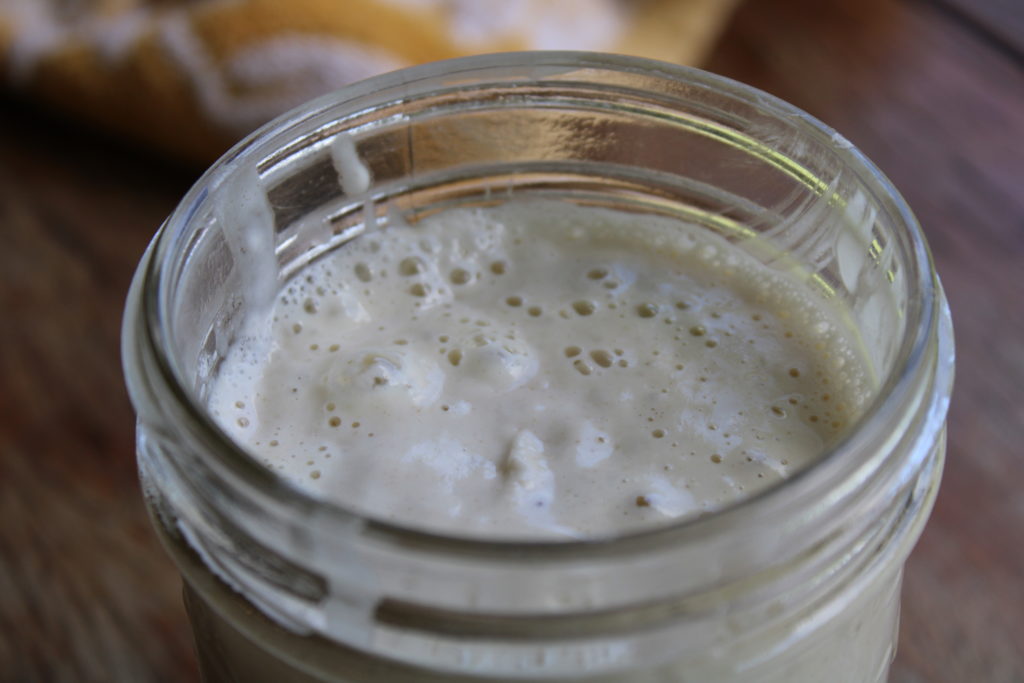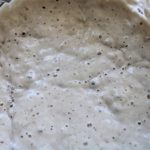Using just flour and water, I’m going to show you how to make your own sourdough starter!
What is a sourdough starter?
A sourdough starter, also called levain, is a fermented dough filled with natural, wild yeast and a bacteria called lactobacilli. The starter is what makes sourdough bread rise. Instead of using commercial yeast like other bread recipes, sourdough bread uses a starter. Along with making the dough rise, the starter also brings that classic sour flavor.
What are some health benefits of sourdough?
Because Sourdough is fermented using a lactobacillus culture, it has probiotics in it that you wouldn’t find in bread using commercial yeast. Hence it becomes more digestible and provides benefits to the healthy gut. People with slight gluten sensitivities have found it more tolerable.


Alright, let’s get to the point. If you are like me when I was searching, you already know you want a sourdough starter and are trying to find some simple instructions on how to start one. Let’s go!
Ingredients and Equipment You’ll Need;
- Flour
- Water
- Quart Mason Jar OR my favorite, a Glass Gallon Jar with Lid
- Wooden Spoon
Day 1
Put 1 cup all-purpose flour and 1 cup filtered water in the jar. Stir well, and make sure everything is fully incorporated. Cover loosely and let sit for 24 hrs.
Day 2
Discard half of the jar’s contents. Add 1 cup flour and 1 cup water into the jar. Stir well and cover. Let sit for 24 hrs.
Days 3-5
Repeat day 2’s steps for days 3, 4, and 5. At this point, you can’t use the discard for any sourdough discard recipes because your starter isn’t mature enough yet. And you have to keep discarding half because you would end up with tons of immature starter if you didn’t.
Days 6-7
Repeat the same steps, but now do it every 12 hours instead of every 24.
After Day 7, you should have a mature bubbly starter and enough to begin baking with! Go ahead and try my Easy Sourdough Recipe and let me know how it goes!

The difference between active starter and discard.
An active starter is when it has risen high in the jar and is all bubbly. This happens 4-12 hours after you feed it. This is what you want when you bake bread or any recipe that calls for a starter that leavens the dough. Before you start your bread, you should do a float test. . . put a spoonful of starter in a cup of water. If it floats, you can make bread. If it sinks, that starter is not going to rise a thing. The starter either has not peaked yet from the feeding, or you missed the peak. If you are a beginner, I’d recommend putting a rubber band around the jar to mark where the starter is after you fed it. That way you can become familiar with how fast it rises, and know when it’s at its peak. The temperature of your house also has a big say in how fast it’ll rise.
Typically when it has been 10-12 hours after a feeding, the starter begins to go back down and weaken. This is your discard! Just because it’s called discard doesn’t mean you should discard it. You can use it in so many yummy discard recipes.
How Do I Maintain A Sourdough Starter?
The question I was most confused about. Because this stuff GROWS. If you left your starter out on the counter, it would get bigger and bigger and the amount of flour and water you’d have to feed it every day would be tremendous. You would have to be baking all day to keep up with all of that starter. Now, there are TONS of sourdough discard recipes that you can make, but you only want to spend so much time in the kitchen, right? So what I like to do is throw my jar of starter in the fridge. It can stay in there for up to 10 days before it needs another feeding. And if I have a recipe that calls for sourdough discard, I just take a scoop of it right out of the fridge. But when I know I’ll be baking bread the next day (remember? You need it to be active to bake bread), I’ll pull it out of the fridge the night before and feed it. Leave it out on the counter and by morning it’s all active and bubbly and ready to bake bread! But let’s say you don’t want to bake for over 10 days. After 10 days in the fridge, pull it out, and feed it. Let it sit out for a couple of hours, then throw it back in the fridge! It’s as simple as that. It is really hard to kill a starter, and there are no set rules with this stuff. You do need to know that you want it active to make bread with.
How much flour and water do I feed my starter?
There are no set measurements on how much to feed a sourdough starter. Basically when feeding time rolls around, whatever is in the jar, you need to feed it that much. Throw in an even ratio of water and flour. That’s why I like keeping mine in the fridge till I know it’s time to bake bread. When I feed it the night before bread-baking day, that feeding will last till next week rolls around. Basically, mine only gets fed whenever I bake bread, bagels, or anything that needs to be risen by the starter.
Easy Sourdough Starter

Learn how to make a sourdough starter using just flour and water.
Day 1. Put 1 cup all-purpose flour and 1 cup filtered water in the jar. Stir well, and make sure everything is fully incorporated. Cover loosely and let sit for 24 hrs.
Day 2. Discard half of the jar's contents. Add 1 cup flour and 1 cup water into the jar. Stir well and cover. Let sit for 24 hrs.
Days 3-5. Repeat day 2's steps for days 3, 4, and 5. At this point, you can't use the discard for any sourdough discard recipes because your starter isn't mature enough yet. And you have to keep discarding half because you would end up with tons of immature starter if you didn't.
Days 6-7. Repeat the same steps, but now do it every 12 hours instead of every 24.
After Day 7, you should have a mature bubbly starter and enough to begin baking with!
When I first started my sourdough starter, I was told that using whole wheat would be the best because the bacteria would have more to feed on. But whole wheat is so much more heavy than all-purpose flour, that I had a difficult time knowing when my starter peaked after feeding it! Even with the float test, it just kept sinking. I had several flops using that starter until I decided to switch over to an all-purpose flour starter. It is just so much more predictable. I do want to go back and attempt a whole wheat starter now that I’m much more familiar with starters. But when first starting, just use all-purpose flour. . . makes your life easier!
This site contains Amazon affiliate links to products. We may receive a commission for purchases made through these links at no additional cost to you.

Leave a Reply